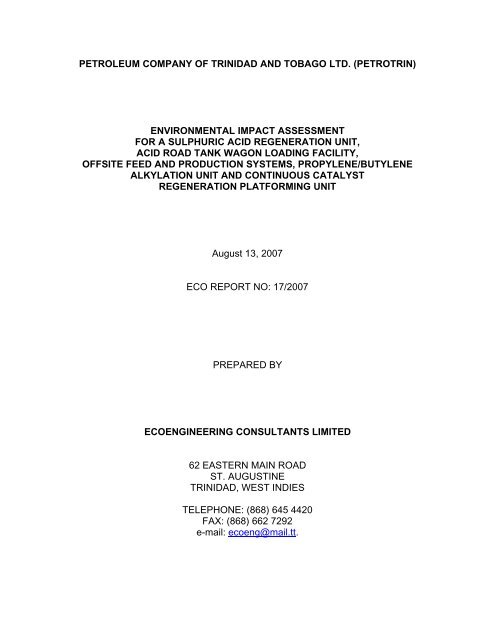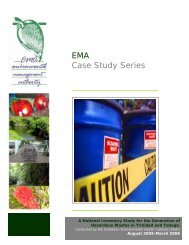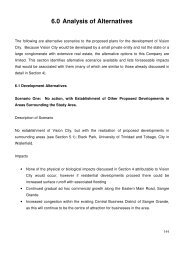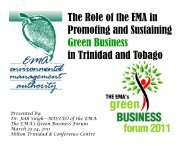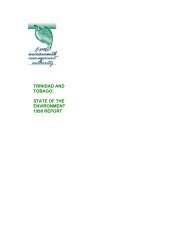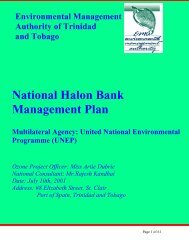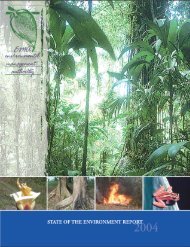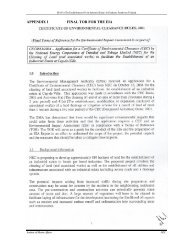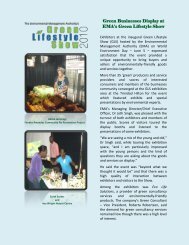Executive Summary - Environmental Management Authority
Executive Summary - Environmental Management Authority
Executive Summary - Environmental Management Authority
Create successful ePaper yourself
Turn your PDF publications into a flip-book with our unique Google optimized e-Paper software.
PETROLEUM COMPANY OF TRINIDAD AND TOBAGO LTD. (PETROTRIN)ENVIRONMENTAL IMPACT ASSESSMENTFOR A SULPHURIC ACID REGENERATION UNIT,ACID ROAD TANK WAGON LOADING FACILITY,OFFSITE FEED AND PRODUCTION SYSTEMS, PROPYLENE/BUTYLENEALKYLATION UNIT AND CONTINUOUS CATALYSTREGENERATION PLATFORMING UNITAugust 13, 2007ECO REPORT NO: 17/2007PREPARED BYECOENGINEERING CONSULTANTS LIMITED62 EASTERN MAIN ROADST. AUGUSTINETRINIDAD, WEST INDIESTELEPHONE: (868) 645 4420FAX: (868) 662 7292e-mail: ecoeng@mail.tt.
PETROLEUM COMPANY OF TRINIDAD AND TOBAGOLIMITED (PETROTRIN)EIA FOR NEW PLANTS AND ACID ROAD TANK WAGONLOADING FACILITY AT POINTE-A-PIERREEXECUTIVE SUMMARYBackgroundPetrotrin proposes to construct and operate three new plants:- A Sulphuric Acid Regeneration Unit, which will process 93 wt% sulphuric acid fromits Propylene / Butylene Alkylation Unit to 99 wt% sulphuric acid and will replace theexisting Acid unit which is undersized and approaching its end of life.- A new Alkylation unit which is designed to convert propylene and butylenes to a highoctane gasoline blending component, alkylate and will replace the existing AlkylationUnit which is undersized and approaching its end of life.- A new Continuous Catalyst Regeneration (CCR) Platforming Unit to convert lowoctane naptha to high octane gasoline and will replace the existing two semiregenerativeplatforming units, which are approaching their end of life.Petrotrin also plans to construct an Acid Road Tank Wagon (RTW) Facility to support operationsof the Acid Regeneration Unit and an offsite feed and product system will be established tomanage the hydrogen sulphide gas feed, sour water stripper gas feed and fresh sulphuric acidsupply to the refinery.This EIA was prepared in accordance with terms of reference provided by the EMA in responseto Petrotrin’s application for a Certificate of <strong>Environmental</strong> Clearance (CEC 1802/2007).Description of the ProjectAll of the proposed new plants are to be constructed within the existing Petrotrin RefineryCompound. The CCR unit is located approximately 375 metres east of the Southern Main Roadand will have a footprint of 1.11 hectares. The Acid Plant and the Alkylation Unit are locatedfurther east approximately 900 metres from the Solomon Hochoy Highway and will both havefootprints of 0.378 hectares respectively. All of the proposed plants and facilities will bedesigned with a minimum project life of 15 years.The proposed plants will be linked to the existing refinery by means of feed, product and utilitystreams. The feed systems include hydrogen sulphide for the acid unit, low octane gasoline forthe CCR unit and LPG for the Alkylation unit.The new plants are components of a larger Gas Optimization Programme (GOP). A newisomerization flare and wastewater treatment facility will form part of the upgrade to facilitate theconstruction and operation of the three new plants.Ecoengineeringi<strong>Environmental</strong>ly appropriatedevelopment for the Caribbean
PETROLEUM COMPANY OF TRINIDAD AND TOBAGOLIMITED (PETROTRIN)EIA FOR NEW PLANTS AND ACID ROAD TANK WAGONLOADING FACILITY AT POINTE-A-PIERREProcess DescriptionThe proposed CCR Unit will be designed with a nameplate capacity of 1,129,360 MTPY, andwill employ standard technology and materials from UOP and Samsung Engineering. This unitwill be designed to operate 337 days per year for a minimum of four years between plannedshutdowns. The CCR unit is designed to convert low octane naphtha from existing operationalprocess units to high-octane gasoline which will be routed to the gasoline “pool” along withproduct from the alkylation unit. The final products from the CCR Unit are: Reformate(1,032,475 MTPY), Unstabilised LPG / light hydrocarbon C3-C4 components (10,153 MTPY)and Fuel Gas/Hydrogen and light hydrocarbons (105,898 MTPY).The new sulphuric acid regeneration plant will have a capacity of 89,403 MTPY and will convert93 wt% sulphuric acid from the Propylene / Butylene Alkylation Unit into 99 wt% sulphuric acidusing design technology from MECS Inc, and will operate 346 days per year for a minimum of 2years between planned shutdowns. This unit will also utilise 637 m 3 /day of hydrogen sulphide(H 2 S) from existing refinery process units.The proposed Propylene / Butylene Alkylation Unit will have a capacity of 337,600 MTPY andwill convert propylene and butylenes into high-octane gasoline blend known as alkylate usingtechnology and materials from Stratco Alkylation Division. The raw materials will be suppliedfrom new and existing operational units as well as via pipeline from Phoenix Park GasProcessors Limited (PPGPL). This unit will be designed to operate 346 days per year for aminimum of 4 years between planned shutdowns. The final products from the alkylation unitare: Alkylate (337,600 MTPY), LPG (light hydrocarbon C3 components) (44,630 MTPY) andLPG (light hydrocarbon C4 components) (144,287 MTPY).Secondary FacilitiesThese will include• An Acid Road Tank Wagon (RTW) Facility to be used to transfer product sulphuric acidor spent acid.• Offsite Feed and Product System comprising Hydrogen Sulphide (H 2 S) Gas Feed; SourWater Stripper Gas Feed; and Fresh Sulphuric Acid Supply to Refinery.Product Storage and TransportReformate product as well any off-spec reformate from the CCR will be routed via pipelines tostorage tanks 8, 29 and 87 with capacities of 76,191, 8,418 and 68,766 barrels respectively,located outside the unit’s battery limits.Whole alkylate from the Propylene / Butylene Alkylation Unit will be stored in Tanks 86 and 18,of nominal capacities 62,000 bbls and 20,000 bbls respectively; aviation alkylate will be storedin Tank 25, of capacity 20,000 bbls.Ecoengineeringii<strong>Environmental</strong>ly appropriatedevelopment for the Caribbean
PETROLEUM COMPANY OF TRINIDAD AND TOBAGOLIMITED (PETROTRIN)EIA FOR NEW PLANTS AND ACID ROAD TANK WAGONLOADING FACILITY AT POINTE-A-PIERREMost of the 99 wt% acid will be stored on-site in a 1,010 m 3 tank. The 98 wt% acid will bestored on-site in two, 283 m3 tanksThe products of the new units will be used for existing operations within the refinery and will berestricted to its battery limits, with the exception of 98-wt% acid produced from the Acid Plant,which will be sold and transported via Road Tank Wagons to consumers outside the Refinery.Operation PhaseUtility RequirementsThe new units will require a ready supply of water, steam, electricity and process air.40 USGPM (CCR Plant) and 176 USGPM (Acid / Alkylation Plants) of process water will bemade available from Petrotrin’s existing Nos. 2 and 3 reservoirs. The proposed refineryupgrade units will also require cooling water, potable water and fire water.A new power substation will be constructed within the refinery battery limits. This electricalpower will be 3 phase current with a frequency of 60 hertz and range in voltage of 66, 000 voltsfor service utilities to 110 volts for lighting.StaffingThe operation of these new units will be continuous (24hrs/day) and major shut downs areanticipated every 36 to 48 months. The Plant will employ at full production approximately 35people (15 for the CCR Plant and 20 for the Acid and Alkylation Plants).WastesDuring operation, air emissions will arise from all the proposed plants. The CCR Unit willproduce approximately 251 mg /Nm 3 NOx, 4.4 mg /Nm 3 SO 2 and 4.0 mg /Nm 3 Particulates. TheAcid Unit will produce approximately 916.16 mg /Nm 3 SO 2 .The main sources of spent process water are the alkaline water wash drum, feed coalescer anddistillation tower accumulator water. The spent alkaline water stream typically has a pH of 10 –12 while water from the feed coalescer and distillation tower accumulator typically has a pH of6.5 ± 0.5. These flow to the Water Degassing Drum where light hydrocarbons and any noncondensablesare flared. Degassed water will be neutralized before releasing to the RefineryWaste Treatment Plants.The likely sources of significant noise during operation include Compressors, Air Coolers,Pumps and Drivers, Relief Valves, Control Valves and Burners. All the units will be designedaccording to Petrotrin’s standard, GEMS (which requires a noise level not to exceed 85 dBA ata distance of 3 ft. from a source), and replace much older units designed to less stringentstandards.Ecoengineeringiii<strong>Environmental</strong>ly appropriatedevelopment for the Caribbean
PETROLEUM COMPANY OF TRINIDAD AND TOBAGOLIMITED (PETROTRIN)EIA FOR NEW PLANTS AND ACID ROAD TANK WAGONLOADING FACILITY AT POINTE-A-PIERREDuring operation, domestic solid waste will be limited to routine maintenance activities and willbe disposed of in accordance with Company’s accepted methods. Process related solid wasteis limited to spent catalysts and adsorbents used in reaction and product treating systems. Thistype of waste is non-routine and will only occur after a number of years in service. Once thecatalyst has been spent, it will be exported to a company that specialises in precious metalrecovery.Pre-construction PhasePre-construction activities will include:- Removal of Gasoline Tanks 205, 206 and 207 (covered separately under CEC1863/2007, CEC 1574/2006, and CEC 1788/2007).- Clearing, Excavating and Grading- Site Filling.Once the tanks are removed the site will be cleared, grubbed, excavated and filled. Debris willbe hauled off-site to a suitable disposal site where it can be composted or a landfill). Topsoil willbe stockpiled on site for future re-use and surplus will be transported to other sites where thismaterial is needed. Approximately 50,000 m 3 of Claxton Bay Red Sand will be used to fill thesite to a depth of approximately 0.3 m.Construction PhaseOn-site construction activities extend from the end of preconstruction to the start ofcommissioning and will include:- Setting-out surveys,- Piling for foundations,- Reinforced concrete for foundations,- Structural steel and reinforced concrete for supports,- Installation of process components,- Installation of pipework,- Installation of electrical and instrumentation items, and- Paving and permanent drains.Labour ForceEmployment is expected to peak at 400 for the CCR Unit and 900 for the Acid/Alkylation Unit,with average values of 340 for the CCR and 500 for the Acid/Alkylation.Ecoengineeringiv<strong>Environmental</strong>ly appropriatedevelopment for the Caribbean
PETROLEUM COMPANY OF TRINIDAD AND TOBAGOLIMITED (PETROTRIN)EIA FOR NEW PLANTS AND ACID ROAD TANK WAGONLOADING FACILITY AT POINTE-A-PIERREWasteAs with preconstruction, discharges during on-site construction will take the form of both airemissions and effluent. Air emissions will include dust from earthworks and vehicular emissions(carbon monoxide and dioxide, sulphur dioxide, nitrogen oxides and organic vapours).Effluent will include oily wastewater, small amounts of used oils and chemicals (solvents, paints,thinners etc) and sewage. The oily wastewater will drain into the existing refinery wastewatertreatment facilities while a septic tank and soak-away system will be installed to treat with thesewage.Noise will originate from the use of heavy equipment as well as the passage of constructionvehicles. Noisy activities will (as far as practical) be limited to daytime hours (7 am to 7 pm).Solid waste streams will consist of uncontaminated soil which will be relocated to the foreshorelandfill to be used as backfill, construction wastes which will be collected in skips andtransported to an approved disposal facility ex-Petrotrin and residual hydrocarbon which will beremoved from the project site and transported in covered dump trucks to the treatment facility.Assembly and CommissioningMajor equipment and material will be procured and shipped from foreign manufacturers.Equipment and material will be trucked from Petrotrin’s port to site using roads within Petrotrin’srefinery.Petrotrin operators will be used to carry out the commissioning, with specialist assistance asrequired. It is expected that, for each plant, approximately 2 such specialists from both theprocess licensors and the engineering contractor companies will carry out pre-commissioningchecks and be present on site during plant commissioning.SchedulingConstruction of the CCR Unit will start in December 2007, mechanical completion will be inFebruary 2009 and plant start up will be in March 2009.Construction of the acid regeneration plant will start in December 2007, mechanical completionwill be by February 2009 and plant start up will be in March 2009.Start of construction of the alkylation Unit will be in December 2007, mechanical completion willbe by February 2009 and plant start up will be in March 2009.Ecoengineeringv<strong>Environmental</strong>ly appropriatedevelopment for the Caribbean
PETROLEUM COMPANY OF TRINIDAD AND TOBAGOLIMITED (PETROTRIN)EIA FOR NEW PLANTS AND ACID ROAD TANK WAGONLOADING FACILITY AT POINTE-A-PIERREDecommissioningAt the end of their design life, there are three basic options for these plants:- Refurbishment,- Mothballing, and- Decommissioning.Description of the EnvironmentClimate, Air Quality, Noise and LightThe Petrotrin refinery compound is located within the Central West Coast Hydrometric Area.Site-specific average annual rainfall decreased from 1778.9 mm in 2000 to 1218.8 mm in 20011995 – 2004 data for Piarco, the prevailing easterly wind for approximately 32% of the time inthe dry season and approximately 20% during the wet season. Average wind speeds during thedry season ranged from 10.6 km/hr to 13 km/hr and during the wet season from 7.2 km/hr to11.9 km/hr. Speeds recorded for Petrotrin in 2003 were 9.5 km/hr to 13.8 km/hr and in 2006these were 1.57 km/hr to 5.86 km/hr.Average monthly temperatures at Piarco (1999 – 2006) ranged from 26.7 o C in January andFebruary to 28.4 o C in May. Average monthly temperatures at Petrotrin (2002 – 2006) werelower than temperatures measured in Piarco. Average monthly temperature for the period2002-2005 ranged from 26°C in November to 28.2°C in May.Highest average monthly relative humidity for the years shown was experienced during themonth of November in 2004 (81.9%), while the lowest was during the month of March in 2005(71.3%). At Petrotrin the highest average monthly relative humidity (2002 – 2005) wasexperienced during the months of November and January (79%), while the lowest was duringthe months of March and April (66%).For the period 1974 to 2005 two extreme weather systems (Fran 1990 and Alma in 1974)affected south Trinidad in the vicinity of the proposed project site.Topography and DrainageThe area for the proposed Acid and Alkylation plants is gently undulating with an elevation ofless than 50 metres above sea level. The topography for the proposed CCR Platforming Unit isflat and at an elevation of less than 25 m.The drainage system within the Petrotrin compound allows surface runoff to enter either theGuaracara River or the Gulf of Paria. Estimated base flow in the Guaracara River may be takenas 2 m 3 /s.Ecoengineeringvi<strong>Environmental</strong>ly appropriatedevelopment for the Caribbean
PETROLEUM COMPANY OF TRINIDAD AND TOBAGOLIMITED (PETROTRIN)EIA FOR NEW PLANTS AND ACID ROAD TANK WAGONLOADING FACILITY AT POINTE-A-PIERREGeology and SoilsGeologically, the entire area is located within the Nariva Formation and a transition zonebetween the Nariva Formation and alluvium of recent origin, associated with the nearbyGuaracara River.Geotechnical studies at the sites indicate the presence of silty clays, silty sand, medium stiffclay, clayey silt and gravel. Excavation at the CCR site where free water was encountered at 2m - 6.5 m below ground level would require adequate dewatering and bracing of cut sides. Atthe site proposed for the acid/alkylation units where the soil is moderately acidic, subsurfacestructures will have to be designed to withstand acidic conditions.SeismicityThe nearest known fault to the project site is the Warm Spring Fault which lies approximately 1km to 2 km to the northwest of the proposed sites. The fault is considered minor and as a resultis unlikely to cause an earthquake of significant magnitude.Soil QualityNo soil testing to determine the levels of soil contamination was conducted for this EIA. Theremoval of the tanks and other appurtenances are the subject of three existing CECs (CEC1789/2007, CEC 1788/2007 and CEC 1574/2006). Soil testing for these sites will be conductedunder those CECs.Water Quality2007 dry season water quality data for the Gulf of Paria indicate pH values within the limitprovided by the DENR Guidelines of 6-9; cadmium concentrations above the limit of 0.05mg/L;small quantities of all other metals; temperatures between 28.3 °C and 28.4 °C; and TSS valuesbetween 6.6 mg/L and 21.1 mg/L.2005 wet season data for the Guaracara River did not detect Chromium, Chromium Hexavalent,Cadmium, Lead, Nickel, Zinc, Mercury and Hexane Extractable Material and indicated lowconcentrations of Iron, Phosphorous and Copper; variable concentrations of Total SuspendedSolids, Chemical Oxygen Demand were detected. Dissolved Oxygen levels were below theDENR standard on both monitoring days.2007 dry season water quality testing in the Guaracara River indicated pH values within the limitprovided by the DENR Guidelines of 6-9 pH units; cadmium above the limit of 0.05mg/L; thepresence of all other metals in small quantities; temperatures between 29.9 °C and 33.4 °C; andTSS values between 36.3 mg/L and 77.9 mg/L.Ecoengineeringvii<strong>Environmental</strong>ly appropriatedevelopment for the Caribbean
PETROLEUM COMPANY OF TRINIDAD AND TOBAGOLIMITED (PETROTRIN)EIA FOR NEW PLANTS AND ACID ROAD TANK WAGONLOADING FACILITY AT POINTE-A-PIERREAir QualitySO 2 was monitored at 6 locations over 10 minute intervals for a total of 39 months over theperiod 2003 to 2007. For eleven months during 2004 to 2007 concentrations exceeded theEMA guideline value of 500 µg/m 3 .Four days of air quality monitoring in May-June 2007 at the two proposed plant locations withinthe Petrotrin compound indicated concentrations of TSP, SO 2, H 2 S and CO generally within therespective Guidelines published by WHO and EMA. TVOCs values were in the range 0.20 ppm– 1.30 ppm.NoiseNoise monitoring was conducted during April – May 2007 at a total of 27 points in and aroundthe proposed locations for the Sulphuric Acid Regeneration, Alkylation Units and CatalystRegeneration Platforming Unit and in the Marabella Community.Within the Marabella area average noise levels ranged from 71.2 dBA to 105 dBA. Refinerynoise contributed to the noise levels obtained at four of the monitoring sites located close to theboundary of the Petrotrin compound. Elevated noise levels within the community areas wereattributed to a combination of traffic movements, refinery noise, radio sounds from houses aswell as children playing. There was an average of 10 dBA decrease in these noise levels as theevening progressed. Within the refinery, noise levels ranged from 81.9 dBA to107dBA.During the morning period noise levels in the Marabella residential area were in the range 78.4dBA to 99.3 dBA and in the refinery between 81.9 dBA to 107 dBA. At midday period noiselevels ranged from 87.1 dBA to 98.7 dBA at the refinery and 82.1 dBA and 96.0 dBA in theresidential area. For the afternoon period noise levels were between 87.8 dBA and 106.6 dBAat the refinery and 84.5 dBA and 100.4 dBA in the residential area. Measured noise levels inboth areas exceeded the respective noise limits of 75 dBA (refinery) and 80 dBA (residentialarea) at all times.Biological EnvironmentThe site is presently occupied by tanks and other appurtenances and has no significantvegetation. Off-site there is a mangrove swamp at the mouth of the Guaracara River with RedMangrove (Rhizophora mangle) present in the inundated areas of the swamp and along theriver edge while Black Mangrove (Avicennia germinans) is found on the consolidated areas.Common species of birds, crustacean and molluscs are found in the swamp. The Pointe-a-Pierre Wildfowl Trust is located within the Petrotrin complex approximately 1.2 km north of theCCR plant site and 1 km from the Acid and Alkylation Plant sites. A wide variety of indigenousand migratory species of birds, such as the Scarlet Ibis (Eudocimus ruber), Anhingas (Anhingaanhinga), geese, herons, ducks and other song birds are found here along with water plantssuch as water hyacinth, water lilies and floating ferns.Ecoengineeringviii<strong>Environmental</strong>ly appropriatedevelopment for the Caribbean
PETROLEUM COMPANY OF TRINIDAD AND TOBAGOLIMITED (PETROTRIN)EIA FOR NEW PLANTS AND ACID ROAD TANK WAGONLOADING FACILITY AT POINTE-A-PIERRESocio-Economic EnvironmentPopulationThe Petrotrin refinery compound is situated within the Couva/Tabaquite/Talparo RegionalCorporation (CTTRC). The closest residential area is Marabella, which falls under the City ofSan Fernando. Residences at Charles Street, Gasparillo are located east of the highway. In2000 Gasparillo had a population of 10,143 in 2,722 households; the Petrotrin residential areahoused 622 persons in 168 bungalows; and the area of Marabella closest to the proposed newconsists of 554 houses with an estimated population of 2,144 persons.Employment and Labour MarketsAn attitude survey was conducted of 66 households (representing some 298 persons) within theMarabella and Gasparillo areas which may be impacted by the construction and operation of thethree new facilities. A total of 108 persons (33%) were employed with the largest occupationgroups being domestic and maintenance (15%), machinery services (12%) and sales andmarketing (11%). There were 38 persons unemployed and actively seeking employment. Theunemployment rate was calculated at 26% which is much higher than the county rates (7.2% inCaroni and 10.1% in Victoria) and national unemployment rate of 8% in 2005.Land UseLand use between Gasparillo in the north to San Fernando in the south consists of industrial,commercial and residential use.Customs, Aspirations and AttitudesA survey of residents was conducted to determine their concerns during the construction andoperation of the new plants. Just over half the respondents expected benefits (increasedemployment less air emissions, better health and less environmental hazards); the mostcommonly expected personal benefit was employment; just less than half of respondentsexpected problems (noise, traffic congestion and dust) during construction; less than half ofrespondents expected problems (noise dust, other air emissions and traffic congestion) duringoperation; the majority of respondents anticipate improved employment opportunities to resultfrom the new plants; one-third of respondents each expect the new plants to improve theenvironment or to make no change; approximately one quarter expect the new plants to lead todeterioration of the environment; less than half of respondents expect the new plants to makeno difference to safety and security, but as many as a quarter expect the new plants to result inan improvement in safety and security; the majority in each case anticipate no change regardingeducational opportunities, recreation opportunities, shopping opportunities, transport, watersupply, and telephone service (both land lines and cellular).Ecoengineeringix<strong>Environmental</strong>ly appropriatedevelopment for the Caribbean
PETROLEUM COMPANY OF TRINIDAD AND TOBAGOLIMITED (PETROTRIN)EIA FOR NEW PLANTS AND ACID ROAD TANK WAGONLOADING FACILITY AT POINTE-A-PIERREA survey of industries was also conducted to determine the concerns of the industries in thearea during the construction and operation of the new plants. Of the eleven companiessurveyed, 45.5% expected business opportunities as a result of the construction of the newplants; although more than half did not think there would be any problems those that expectedproblems identified dust, traffic and a reduction in the amount of available skilled labour. Onequarter of the respondents did not anticipate any problems during the operation phase and ofthose who expected problems, air emissions were of greatest concern during the operationphase.Road TrafficPetrotrin can be accessed by two major roadways: the Southern Main Road and the SolomonHochoy Highway. Traffic counts were conducted during the morning at three locations. Trafficat the Gasparillo gate peaks at 200 vehicles per 15 minute interval from 6:45 am to 7:15 am; atthe Southern Main Road traffic on the north bound lane peaks at 310 vehicles per 15 minuteinterval during the period 6:15 am to 7:15 am; and at the guard shack on Avenue Main Road,half of the Gasparillo traffic passes through to the Southern Main Road at a peak of 90 vehiclesper 15 minute interval. Traffic congestion at both the Southern Main Road and the SolomonHochoy Highway is clearly recognised as a concernServices and UtilitiesHistorically Petrotrin has developed and maintained its own network of services and utilitieswithin the refinery compound. Currently, water and steam systems do not interface with publicutilities. Part of the upgrades for the operation of the three new plants is the construction of anew sub-station which has a rated design capacity of 100 MW. It is expected that 23 MW willbe required for the 3 new plants. The remainder will be used for existing plants as well as forfuture development. Existing water systems are expected to support the additional waterrequirements of the proposed plantsEmergency ServicesPetrotrin operates a Medical Center and a 24-hour hospital, both located within its compound.A functional helipad associated with the Augustus Long Hospital is located within the refinerycompound which is used in emergencies to receive sick or injured personnel for treatment at theAugustus Long Hospital.The company also maintains a twenty-four hour site emergency response capability through theoperation of its Fire Department. Personnel are trained in fire protection and hazardousmaterials response and the department is equipped with fire tenders and portable foamsystems, “hazmat” capability and ambulance.Ecoengineeringx<strong>Environmental</strong>ly appropriatedevelopment for the Caribbean
PETROLEUM COMPANY OF TRINIDAD AND TOBAGOLIMITED (PETROTRIN)EIA FOR NEW PLANTS AND ACID ROAD TANK WAGONLOADING FACILITY AT POINTE-A-PIERRELegislative and Regulatory ConsiderationsThis project will be governed by the policies and practices of Petrotrin; as well as theenvironmental requirements of the <strong>Environmental</strong> <strong>Management</strong> <strong>Authority</strong> (EMA), the Town andCountry Planning Division (TCPD) and the Ministry of Energy and Energy Industries (MEEI).The following subsidiary legislation will also apply:- Certificate of <strong>Environmental</strong> Clearance Rules, 2001,- Water Pollution Rules, 2006.- Noise Pollution Control Rules, 2001,- <strong>Environmental</strong>ly Sensitive Areas Rules, 2001,- <strong>Environmental</strong>ly Sensitive Species Rules, 2001,- Draft Air Pollution Rules, 2005, and- Draft Waste <strong>Management</strong> (Solid Waste) Rules, 2000.The following is a listing of the environmental approvals required for the proposed plants:Certificate of <strong>Environmental</strong> Clearance (EMA)Outline Planning Approval (TCPD)Final Planning Approval (TCPD)Approval of the Plant for Operation (MEEI)Completion Certificate (CTTRC)Waste Disposal/Collection Permit (CTTRC)Approval of Drainage System (MOWT)Approval to Transportation of heavy equipment and material on roadways (MOWTPotential ImpactsProject BenefitsThe expected benefits of this refinery expansion are:During Construction- Increased employment in the Construction Industry- Increased business for fabrication shops.During Operation- Increase Gasoline Quantity & Quality (Total from 21% to 30%);- Increase Motor Octane Number from 82.3 to 86.2;- Eliminate Unfinished Products (Naphtha & Vacuum Gas Oil);- Improved Operations of the P-a-P Refinery;- Energy Efficiency ;- <strong>Environmental</strong> Compliance;- Lower NOx Burners (CCR);Ecoengineeringxi<strong>Environmental</strong>ly appropriatedevelopment for the Caribbean
PETROLEUM COMPANY OF TRINIDAD AND TOBAGOLIMITED (PETROTRIN)EIA FOR NEW PLANTS AND ACID ROAD TANK WAGONLOADING FACILITY AT POINTE-A-PIERRE- Acid Plant as back up for SRU – Lower SOx;- Secondary Treatment of Effluent;- Smokeless Flare;- Maintain Throughput at 168 MBPCD; and- Ability to eliminate MTBE.Adverse ImpactsThe potential impacts of this development were assessed on a quantitative basis wherepractical, and on a qualitative basis in other cases. Different degrees of sophistication wereused in assessing different impacts. Where mitigation measures were recommended, theassessment assumes that these measures will be implemented.The classification of impacts after mitigation was based on extent, intensity and duration.A summary of impacts associated with the construction and operation of the proposed plants ispresented in the table below.IMPACT EXTENT INTENSITY DURATION CLASSIFICATIONWater Quality: FuelSpills/Disposal ofSpent LubricantsWater Quality:Sediment MigrationOverlandNoiseVibrationAir Quality: Exhaustand Dust fromVehiclesAir Quality: Dustfrom Cleared AreasAir Quality: Dustfrom Stock piling ofAggregatesEcoengineeringCONSTRUCTION PHASEPlant Site Very Small Short-Term LOWRefineryWideRefineryWideRefineryWideVery Small Short-Term LOWMinor Short-Term LOWMinor Short-Term LOWRegional Very Small Short-Term LOWRefineryWideRefineryWideMinor Short-Term LOWVery Small Short-Term LOWSoil Contamination Plant Site Very Small Short-Term LOWTransportation Regional Minor Short-Term MODERATEPublic Health &SafetyRegional Very Small Short-Term MODERATEWorker Health andSafetyRefineryWideVery Small Short-Term LOWxii<strong>Environmental</strong>ly appropriatedevelopment for the Caribbean
PETROLEUM COMPANY OF TRINIDAD AND TOBAGOLIMITED (PETROTRIN)EIA FOR NEW PLANTS AND ACID ROAD TANK WAGONLOADING FACILITY AT POINTE-A-PIERREIMPACT EXTENT INTENSITY DURATION CLASSIFICATIONWaste DisposalWater Quality:Surface Run-offWater Quality:Effluent WaterRefineryWideRefineryWideVery Small Short-Term LOWOPERATIONAL PHASEVery Small Long-Term MODERATERegional Very Small Long-Term MODERATETransportation Regional Very Small Long-Term MODERATEWorker Health andSafetySolid Waste<strong>Management</strong>Risk AssessmentRefineryWideMinor Long Term MODERATEPlant Site Very Small Long-Term LOWRisks associated with the construction and operation of the proposed new plants are presentedin four Risk Assessment Reports:- Qualitative Risk Assessment for Construction, Operation, Maintenance andDecommissioning of the New Propylene / Butylene Alkylation Unit;- Qualitative Risk Assessment for Mobilization, Construction, Operation, Maintenanceand Decommissioning of the New Sulphuric Acid Regeneration Unit;- Qualitative Risk Assessment for Mobilization, Construction, Operation, Maintenanceand Decommissioning of the New Continuous Catalyst Regenerating PlatformingUnit; and- Petrotrin Refinery Quantitative Risk Assessment.Analysis of AlternativesNo-action alternativeThe units that are being replaced are over 40 years old. If no action is taken to upgrade theseexisting units, there will be a high frequency of equipment failure, an excessive number ofshutdowns and slowdowns and attendant high maintenance cost. There will also continue to bethe need to burn excess H 2 S which will result in the release of SO 2 . Therefore, residents willcontinue to experience the adverse conditions associated with gaseous releases.Ecoengineeringxiii<strong>Environmental</strong>ly appropriatedevelopment for the Caribbean
PETROLEUM COMPANY OF TRINIDAD AND TOBAGOLIMITED (PETROTRIN)EIA FOR NEW PLANTS AND ACID ROAD TANK WAGONLOADING FACILITY AT POINTE-A-PIERREProcess technologyFixed Bed Reactors and Continuous Catalyst Regeneration (CCR) were considered for the CCRUnit. UOP was selected as the supplier of continuous catalyst regeneration unit based on theirsuperior experience level.Two process technologies were considered for the Acid Plant. The MECS double absorptionprocess was chosen as it is the market leader in regeneration of acid from Alkylation units.Two technologies are available for the alkylation of propylene and butylenes with iso-butane toproduce gasoline. STRATCO was selected based on their superior experience level.Site selectionSite selection was based on keeping units using hydrogen together and locating this unit asclose as possible to existing NOs 1 & 2 CRUs to maximize re-use of existing offsite facilities.Site selection for the Acid Plant was based on the need to minimize the risk associated with thepiped transport of acid and H2S as well as minimizing the risk of exposure to acid gasemissions. Site selection for the Alkylation Plant was based on locating this unit as close aspossible to the FCCU / GCX area thereby keeping the units processing LPG type materialtogether.Construction methodsThe main alternative considered for construction was using the modular approach for the CCRRegenerator section versus the conventional stick built from ground up. The modular approachwas selected as it reduced the overall schedule but, more importantly, the time spent working athigh elevations. No specific construction method alternatives were considered for theconstruction of the Acid or Alkylation Units.Effluent treatmentConventional methods used for treatment of solid waste and effluents from the CCR and theAcid Plant were selected.UtilitiesThe facilities have been designed to minimize the need for fresh water by maximizing air coolingand by using electrical power instead of steam where feasible.Ecoengineeringxiv<strong>Environmental</strong>ly appropriatedevelopment for the Caribbean
PETROLEUM COMPANY OF TRINIDAD AND TOBAGOLIMITED (PETROTRIN)EIA FOR NEW PLANTS AND ACID ROAD TANK WAGONLOADING FACILITY AT POINTE-A-PIERRE<strong>Management</strong> Plan to Mitigate Negative ImpactsA summary of the recommended mitigation measures is presented in the following table:SUMMARY OF MITIGATION MEASURESPOTENTIAL ADVERSEENVIRONMENTAL IMPACTOn-Site ErosionWater Quality(Disposal ofHydrotest water)Water Quality (Fuel spills anddisposal of spent lubricants)Water Quality (Sedimentmigration)CONSTRUCTION PHASEMITIGATION MEASURE• Provide temporary drains during pre-construction tocontrol runoff; and• Conduct site preparation work only in areas that arerequired for the project.• If water quality is acceptable, recycle hydrotest waterback into the hydrant water system; and• Consider "staging" of pressure testing, so that water canbe used to test multiple pieces of equipment, tanks orsections of piping before being discharged.• Fuel and service vehicles offsite;• Routinely service vehicles and construction machinery toensure no leakage from equipment;• Use of appropriate pumps and nozzles for refuelling;• Place disconnected hoses in containers to prevent spillsfrom residual fuel;• Transport collected spent lubricants off-site to a facilitycapable of treating and/or disposing of waste of this kind;and• Remove all soil which may become contaminated duringthe course of construction to a site earmarked forstockpiling this contaminated material. This will then betransported to a bioremediation cell for treatment (on-siteremediation may be considered if the volumes are small).• Keep material stored on site to a minimum; and• Install siltation traps (using either hard or soft solutions)within drains to trap silt before it enters any watercourseoutside of the site.Ecoengineeringxv<strong>Environmental</strong>ly appropriatedevelopment for the Caribbean
PETROLEUM COMPANY OF TRINIDAD AND TOBAGOLIMITED (PETROTRIN)EIA FOR NEW PLANTS AND ACID ROAD TANK WAGONLOADING FACILITY AT POINTE-A-PIERREPOTENTIAL ADVERSEENVIRONMENTAL IMPACTMITIGATION MEASURENoise • Schedule night time (after 7 pm) heavy vehicularmovements to a minimum to the extent practical;• If noise intensive activities (such as pile driving) arerequired at night, apply for and obtain a noise variationfrom the EMA ;• Schedule on-site construction activities within normalworking hours to the extent practical;• Require contractors to conduct regular inspections andmaintenance activities on construction vehicles andequipment to ensure noise emission control systems areproperly functioning.Air Quality (exhaust and dustfrom vehicles)Air Quality (dust from clearedareas)Air Quality (dust fromstockpiling of aggregates)Soil Contamination• Cover the trays of all vehicles transporting dirt,construction aggregate, etc. to, from and within the site;• Implement dust control measures at the source ofemissions. The standard method is to wet earthworks andhaul roads; and• Enforce traffic speed regulations within the constructionzone as speeding along roads can contribute to dustemissions. At present, the speed limit within the complexis 40 km/hr.• Implement dust control measures at the source ofemissions, the standard method being to wet exposedsurfaces on which construction equipment will run;• Pave the area as soon as practical; and• Phase the construction of project components such thatareas are cleared and paved at different times to reducethe potential for dust from cleared areas.• Site dirt and aggregate stockpiles away fromneighbouring buildings (and downwind if practical);• Keep stockpiles to a minimum and use as soon aspractical;• Use of construction material at other sites so as tominimise storage at any one area; and• Cover smaller stockpiles, or store fine aggregates in binsor silos.• Measures used to mitigate against fuel spills and disposalof spent lubricants are also applicable here.Ecoengineeringxvi<strong>Environmental</strong>ly appropriatedevelopment for the Caribbean
PETROLEUM COMPANY OF TRINIDAD AND TOBAGOLIMITED (PETROTRIN)EIA FOR NEW PLANTS AND ACID ROAD TANK WAGONLOADING FACILITY AT POINTE-A-PIERREPOTENTIAL ADVERSEENVIRONMENTAL IMPACTMITIGATION MEASURERoad TransportationPublic Health &Safety• Schedule material and equipment deliveries along publicroad for off-peak traffic periods, to the extent practical;• Inform Petrotrin community of the movement of materialsand personnel within the refinery compound;• Station flagmen at the intersection between the existingroad and the site access road to control traffic;• Use out-riders when transporting long or wide loads;• Provide designated areas for off-loading so as to notaffect pedestrians and other users;• Use buses from the parking lots through the securitygates to work points/offices;• Use multiple entries/ exits;• Widen the Gasparillo entrance, place the guard shacksfarther inside the plant from the main road; Create aparking lot in the CCR lay down area north of the labouroffice on the west side of The Southern Main road;• Parking for the FCCU and ALKY plants will be through anexpanded Fluor parking lot and FCCU proposed parkinglot;• Create a maxi offloading area near the south entrance toget the Taxis off the road and improve vehicle flow;• The contractor will be required to inspect and verify theload capacity of all roads culverts and bridges beforesubjecting them to above-normal loads; and• It is standard practice in Trinidad that contractors mustrepair (at their own cost) any roads, culverts or bridgeswhich are damaged by their activities.• Comply with the Highways Act, the Motor Vehicle andRoad Traffic Act; and• Consult with the Police Service in the affected areas.Ecoengineeringxvii<strong>Environmental</strong>ly appropriatedevelopment for the Caribbean
PETROLEUM COMPANY OF TRINIDAD AND TOBAGOLIMITED (PETROTRIN)EIA FOR NEW PLANTS AND ACID ROAD TANK WAGONLOADING FACILITY AT POINTE-A-PIERREPOTENTIAL ADVERSEENVIRONMENTAL IMPACTWorker Health &SafetyMITIGATION MEASURE• Hire companies with a proven HSE track record;• All contractors and sub-contractors must adhere toPetrotrin's existing Safety Policy and safety requirements;• All contractors and sub-contractors must employconstruction "good practices" to safeguard workersthroughout the construction period;• All contractors and sub-contractors must require that theirpersonnel wear the necessary Personal ProtectiveEquipment (PPE), for example, hard hats, steel tip boots,safety glasses, welding shades, etc; and• The contractor must properly demark the constructionzone by the placement of appropriate signs, barriers andlighting.Waste Disposal <strong>Management</strong> • Burning of waste on site (packaging material,construction scraps, etc.) will not be permitted, asopen burning will constitute a significant risk in anoil refinery and also produce unacceptable airemissions;• Excess excavated dirt should be disposed of inareas away from water-bodies, so as to minimizethe possibility of siltation or blockage;• Construction workers should use portable toiletfacilities which will be emptied on a regular basisand appropriately disposed;• Collect all spent lubricants for re-cycling, re-use orappropriate disposal; and• Collect spills with appropriate absorbent materialsand dispose of appropriately.Water Quality(Surface runoff)OPERATION PHASE• Route all potentially contaminated runoff throughthe on-site oil water separators;• Collect used oil and dispose appropriately;• Clean all spills and leaks as they occur, using oilor chemical absorbent materials; and• Store all on-site fuels, chemicals and lubricants atspecially designated areas, protect by secondarycontainment (impervious flooring, catch-pansand/or bunds) and cover to protect from rainfall.Ecoengineeringxviii<strong>Environmental</strong>ly appropriatedevelopment for the Caribbean
PETROLEUM COMPANY OF TRINIDAD AND TOBAGOLIMITED (PETROTRIN)EIA FOR NEW PLANTS AND ACID ROAD TANK WAGONLOADING FACILITY AT POINTE-A-PIERREPOTENTIAL ADVERSEENVIRONMENTAL IMPACTTransportationWorker Health &SafetySolid Waste<strong>Management</strong>MITIGATION MEASURE• Chemical containers will meet US DOT specifications fortransport and storage; and• Drivers of trucks will be trained in the safe handling andtransport of hazardous materials.• Brief all employees on the disaster and emergencyreporting response procedures.• Post disaster and emergency response procedures andtelephone numbers at key locations throughout thecomplex.• Identify those competent persons trained in emergencyprocedures.• Carry out announced and un-announced drills toascertain the effectiveness of the training.• Solid waste will be stored in designated areas in speciallymarked containers;• Solid waste will be removed in a timely fashion andproperly disposed;• Materials used to clean spills of oil and lubricant will bedisposed of at an appropriate facility;• Spent chemical storage containers will be sent back tothe manufacturer or send for disposal at an appropriatefacility; and• Spent adsorbent material will be sent back to themanufacturer for disposal.Supplementary plans were also formulated to address concerns with the following:- Efficient Use of Freshwater;- Protection of Surface Water Quality;- Hazardous Materials <strong>Management</strong> Plan;- Mitigation of Altered Drainage Patterns;- Erosion and Sedimentation Controls;- Spill and Emission Procedures;- Waste management;- Conceptual Contingency Plan;- Mitigation and Monitoring Measures to minimize noise and light;- Social Impact or Community management Plans;- Traffic <strong>Management</strong> Plans; and- Emergency Response Plans.Ecoengineeringxix<strong>Environmental</strong>ly appropriatedevelopment for the Caribbean
PETROLEUM COMPANY OF TRINIDAD AND TOBAGOLIMITED (PETROTRIN)EIA FOR NEW PLANTS AND ACID ROAD TANK WAGONLOADING FACILITY AT POINTE-A-PIERREMonitoring PlanA monitoring plan has been developed for implementation during both the construction andoperation phases of these plants as shown in the table below:MONITORING PROGRAMMECONCERN ACTIVITY SUGGESTED FREQUENCYCONSTRUCTIONWater QualityNoiseWater quality monitoring will be conductedin accordance with the existing refinerywidemonitoring program.1 hour noise monitoring will be conductedwithin the nearby Marabella community.RoutinelyconstructionduringOnce per week during piledrivingAir QualitySoil ContaminationWorker Health andSafetyPublic ConcernsConduct 24-hour monitoring for TSP andPM 10 upstream and downstream ofconstruction site. This should be done atactive work sites closest to residentialareas.All vehicles and equipment will be routinelyserviced.Visual inspections of surrounding areas forsigns of soil contamination.All workers will be required to completeHSE trainingPublic Education CampaignEstablish line of communication forcommunity and other industriesAll concerns and actions taken will berecorded and made available if requestedby the relevant authoritiesOPERATIONFortnightlyRoutinelyduringconstructionRoutinelyduringconstructionAs necessaryPrior to ConstructionAs necessaryWater Quality Effluent from API Units will be pH tested. WeeklyEcoengineeringxx<strong>Environmental</strong>ly appropriatedevelopment for the Caribbean
PETROLEUM COMPANY OF TRINIDAD AND TOBAGOLIMITED (PETROTRIN)EIA FOR NEW PLANTS AND ACID ROAD TANK WAGONLOADING FACILITY AT POINTE-A-PIERRECONCERN ACTIVITY SUGGESTED FREQUENCYCCR Plant - the discharge from the InducedGas Flotation Unit and the effluent from theSimpson’s Oil Catch. Parameters include:Temperature, TPH, COD, Cyanide, Nickel,Zinc, Lead, Ammonia, Phenols, TSS,Chromium, Copper and, Cadmium.WeeklyNoise and VibrationAir QualityWorker Health andSafetyPublic ConcernsAcid Plant - at the neutralizing system andat the outlet of the induced gas floatationunit.pH testing will be measured at theNeutralization System. Parameters to bemonitored are the same as thosementioned above for the CCR Plant.Alkylation Plant - at the neutralizing systemand at the outlet of the induced gadfloatation unit.pH testing will be measured at theNeutralization System. Parameters to bemonitored are the same as thosementioned above for the CCR Plant.Noise monitoring will be conducted at thefenceline and within the Marabellacommunity.Air quality monitoring will be conducted atdesignated locations. Parameters to memeasured include TSP,SO2, H2S and CO.Workers are to be briefed on emergencyresponse and will adhere to HSE policies.Drills will be carried out to ascertaineffectiveness of training.Establish a line of communication withindustries and communities. All concernsand actions taken will be recorded andmade available if requested by the relevantauthoritiesWeeklyWeeklyOnce within the first 3months of operation andtwice annually thereafter.Twice a weekRoutineAs necessaryEcoengineeringxxi<strong>Environmental</strong>ly appropriatedevelopment for the Caribbean
PETROLEUM COMPANY OF TRINIDAD AND TOBAGOLIMITED (PETROTRIN)EIA FOR NEW PLANTS AND ACID ROAD TANK WAGONLOADING FACILITY AT POINTE-A-PIERREConsultation and Public ParticipationThis EIA included a program of inter-agency and public consultation undertaken as follows:- Consultation with Key Stakeholders on the draft Terms of Reference,- Business Surveys in the Marabella area, south of the Petrotrin Refinery,- Resident Attitude Survey in the Gasparillo and Marabella (East and West of theSouthern Main Road) areas,- Meetings with Public and key Stakeholders.The main concerns addressed during consultation on the draft TOR were enquiries regardingpossible solutions to the problems associated with the existing flare and Acid Plant, drainageissues and compensation for the maintenance of homes damaged by fumes from the plant. Themain item of concern that Petrotrin sought to address was the reduction in the source ofemissions from the flare and Acid Plant.The results of an attitude survey of businesses in Marabella in close proximity to the refinery aresummarized in the section above on Customs, Aspirations and Attitudes.Four consultation meetings were held with the public and NGOs. The main concerns raisedwere location of the flare, height of the flare, access, operation times, acid emissions, naturaldisasters, utility awareness, fire, run-off, and employment. Downstream opportunities wereidentified as a project benefit.Ecoengineeringxxii<strong>Environmental</strong>ly appropriatedevelopment for the Caribbean


